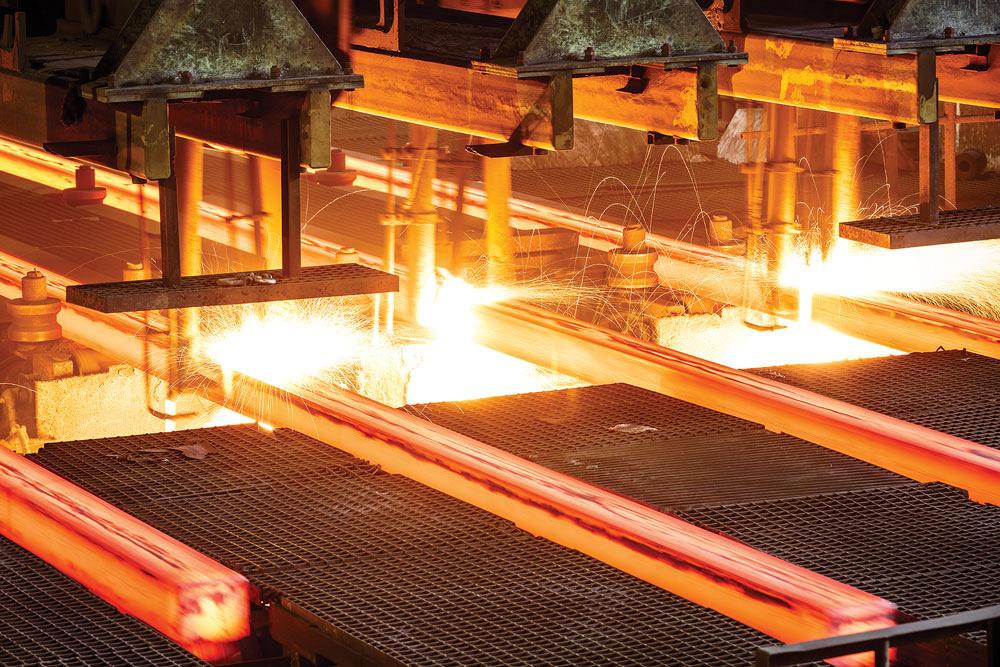- FMA
- The Fabricator
- FABTECH
- Canadian Metalworking
Upgrading iron and steel plants can save two years of global carbon emissions
- December 15, 2023
- News Release
- Management

Research shows how to reduce carbon emission in iron and steel production. zhaojiankang/iStock/Getty Images Plus
Retrofitting the world's iron and steel processing plants early could reduce carbon emissions by up to 70 gigatonnes (GT) by 2050, or roughly the equivalent of two years’ worth of net global carbon emissions, according to a new study.
Published in the journal Nature, researchers found that upgrades could reduce carbon emissions by 58.7 GT between 2020 and 2050. In addition, they found that by performing emissions reduction retrofits five years ahead of when they would typically be scheduled would reduce emissions by 69.6 GT over that time frame.
Currently, iron and steel production contribute about 7 per cent to total global carbon emissions.
The top five carbon-emitting iron and steel plants contribute 7 per cent of the total CO2 emissions from the global iron and steel.
- Anshan Iron & Steel (China),
- Posco - Pohang Iron & Steel (South Korea)
- Shanghai Baosteel (China)
- Jiangsu Shagang (China)
- Maanshan Iron & Steel Group (China)
To develop this schedule, the team created a comprehensive database of 19,678 individual processing units located in 4,883 individual iron and steel plants around the world, inventoried by their technical characteristics, including their locations, processing technologies, operating details, status, and age.
The researchers found that as of 2019, the last year that data is available, 74.5 per cent of the world’s steel was produced in coal-powered plants that release considerable carbon emissions. Technologies exist to reduce these emissions, but upgrades are expensive and time-consuming and usually are undertaken at the end of a processing unit’s operational lifetime.
Refining is also hard on the equipment, and the individual processing units within each plant need to be retrofitted periodically to prolong their operational lifetimes. Overall, 43.2 per cent of global iron and steel plants have been retrofitted with new technologies or have otherwise enhanced their processes to extend their operating lifetime. The frequency of their retrofits depends on the technique they employ and how old they are, but typically they occur after 15 to 27 years of use.
The researchers found that if all currently operating processing units were upgraded to incorporate low-emissions technology at their predicted time of their refit, total emissions from the iron and steel sector could be reduced by 58.7 GT between 2020 and 2050. However, if all the refits and upgrades were bumped forward and completed five years early, the total carbon savings would be 16 per cent greater at 69.6 GT.
Because of the complexity and variety of methods involved in steel production around the world, there’s no one-size-fits-all decarbonization technology for the entire sector, and each processing unit should be upgraded individually according to its technical specification.
“Our results lend vivid background to the possibility of achieving net-zero carbon emissions in iron and steel production in the future. By retrofitting existing plants with low-carbon technologies and improving scrap collecting and recycling, the iron and steel sector can dramatically reduce its carbon emissions,” said senior author Dabo Guan, professor at the University College London (UCL) Bartlett School of Sustainable Construction.
The researchers hope that this data can be used to identify improved ways to update ageing steel plants with emission reduction technologies to reach net-zero carbon emissions more quickly.
The research was led by UCL and conducted in collaboration with Tsinghua University, Peking University, and King's College London.
subscribe now


Keep up to date with the latest news, events, and technology for all things metal from our pair of monthly magazines written specifically for Canadian manufacturers!
Start Your Free Subscription- Trending Articles
Automating additive manufacturing

Sustainability Analyzer Tool helps users measure and reduce carbon footprint

CTMA launches another round of Career-Ready program

Sandvik Coromant hosts workforce development event empowering young women in manufacturing

GF Machining Solutions names managing director and head of market region North and Central Americas

- Industry Events
MME Winnipeg
- April 30, 2024
- Winnipeg, ON Canada
CTMA Economic Uncertainty: Helping You Navigate Windsor Seminar
- April 30, 2024
- Windsor, ON Canada
CTMA Economic Uncertainty: Helping You Navigate Kitchener Seminar
- May 2, 2024
- Kitchener, ON Canada
Automate 2024
- May 6 - 9, 2024
- Chicago, IL
ANCA Open House
- May 7 - 8, 2024
- Wixom, MI














